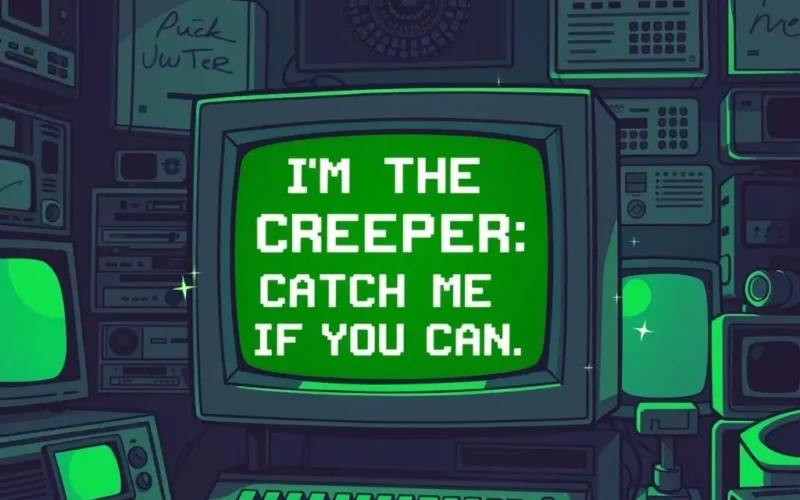Ever wondered where the concept of computer viruses and the software designed to fight them came from? It’s a story that doesn’t begin in a dark basement with malicious intent, but in the optimistic dawn of networked computing, with an experimental program that was more playful than threatening. Get ready for a wild ride back to the early 1970s!
Table of Contents
Setting the Stage: The Birth of the Network
Our story unfolds on the Advanced Research Projects Agency Network, or ARPANET. This was the predecessor to the modern internet, a groundbreaking project designed to connect research institutions across the United States. In this nascent digital universe, rules were still being written, and the possibilities seemed limitless. It was a time for exploration, experimentation, and pushing the boundaries of what computers could do, especially when linked together.
Enter the Creeper: The Original Digital Prankster
Working at BBN Technologies (Bolt Beranek and Newman), a key contractor for the ARPANET, programmer Bob Thomas had a fascinating idea. What if a program could move from one computer to another on its own? It wasn’t about causing harm; it was an experiment in ‘mobile code’ – a self-replicating program that could traverse the network.
He created just such a program, aptly named Creeper. Creeper was designed to travel across the ARPANET, specifically jumping between DEC PDP-10 computers running the TENEX operating system. When Creeper arrived on a machine, it didn’t steal data, encrypt files, or crash the system. Its sole purpose was to display a simple, slightly cheeky message on the teleprinter terminal:
I'M THE CREEPER : CATCH ME IF YOU CAN.
Sometimes, it would just display the message and move on, leaving a copy behind. Other times, it would delete its previous incarnation before moving to a new machine, making it feel like it was truly hopping from place to place.
Think of Creeper not as a cyberthreat in the modern sense, but as an early, rather persistent digital graffiti tag or a game of tag played across the wires. It was a proof-of-concept, demonstrating a capability that, while benign in this instance, held significant implications for the future.
Before we delve into the inevitable response to Creeper, take a moment to visualize this retro tech tale with our short video:
The Challenge Issued: Catch Me If You Can!
While not destructive, a program that replicated and appeared unbidden on terminals was certainly an annoyance. It occupied system resources and, more importantly, highlighted the fact that unauthorized programs could spread across a network. The message “CATCH ME IF YOU CAN” wasn’t just a line of text; it was an implicit challenge in this new digital frontier.
This experimental ‘bug’ demanded a solution. If a program could spread itself, another program should be able to find and remove it.

The Response: The Birth of the Digital Guardian
The task of catching the Creeper fell to none other than Ray Tomlinson, also working at BBN. Tomlinson is a legendary figure in the history of computing, most famous for inventing email (and choosing the ‘@’ symbol). But his contributions didn’t stop there.
To deal with Creeper, Tomlinson created another program. This program was designed explicitly to travel the ARPANET, find instances of the Creeper program, and delete them. He called this program Reaper.
Reaper was essentially a self-replicating program itself, but with a beneficial purpose from the user’s perspective. It sought out and destroyed the Creeper, acting as a digital disinfectant.

The First Digital Cat-and-Mouse
The creation of Creeper and Reaper was a watershed moment. It wasn’t a cybersecurity crisis in the modern sense, but it was the very genesis of two fundamental concepts in computing:
- The self-replicating program (the ancestor of the virus/worm).
- The program designed to detect and eliminate it (the ancestor of antivirus software).
This was the first known instance of a digital program created specifically to combat another digital program that was spreading autonomously across a network. A primitive, yet profound, cat-and-mouse chase played out in the early digital ether.
A Pioneering Chapter
The story of Creeper and Reaper is far more than a historical footnote. It’s a foundational tale in the history of cybersecurity, demonstrating a fundamental principle that continues to hold true: for every new digital capability, there is the potential for misuse or unintended consequence, and thus, the necessity for countermeasures. Bob Thomas wasn’t trying to be malicious, and Ray Tomlinson wasn’t building a corporate empire, but their experimental programs laid the groundwork for the massive, complex, and critical cybersecurity industry we have today. From a simple message on a terminal to sophisticated global threats, the lineage traces back to this bizarre, true story on the early ARPANET.
Frequently Asked Questions
Q: Was Creeper a virus like the ones today?
A: No, not in the modern sense. Creeper was experimental and non-malicious. It didn’t steal data, encrypt files, or cause system damage. It simply displayed a message and replicated. Modern viruses are typically designed for harmful purposes like data theft, destruction, or disruption.
Q: Why is Reaper considered the first antivirus?
A: Reaper is often called the first antivirus because its specific function was to find and delete the self-replicating program, Creeper. This objective—identifying and removing spreading software—is the core function of antivirus software.
Q: Did Creeper and Reaper spread widely?
A: They were confined to the ARPANET, a relatively small network connecting research institutions, specifically the DEC PDP-10 computers running the TENEX OS. They didn’t spread globally like modern malware.
Q: Who created Creeper and Reaper?
A: Bob Thomas created Creeper, and Ray Tomlinson created Reaper. Both worked at BBN Technologies.
Q: When did this happen?
A: The Creeper program is generally dated to 1971, with Reaper following shortly after, in the early 1970s.






